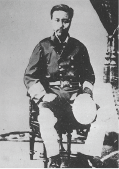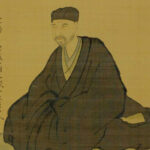

1847 – 1934
東郷平八郎
Heihachiro Togo
A Legendary Admiral Who Shaped Japan’s Naval Legacy
Early Life
Heihachiro Tōgō was born in 1848 in Satsuma (present-day Kagoshima), coming from a samurai family. From a young age, he dedicated himself to academics, swordsmanship, and sumo wrestling. In Satsuma, the secretive sword style Jigen-ryū was passed down, and Heihachiro maintained a strong connection to its teachings throughout his life. Famous for its powerful downward strikes and focus on the first blow, Jigen-ryū’s philosophy of “abandoning wisdom” resonated deeply with Heihachiro, even after witnessing the might of the British Royal Navy. This formidable style influenced Japanese culture and is still depicted in manga and anime, such as Rurouni Kenshin and Golden Kamuy.
First Encounter with the British
At just the age of 16, Heihachiro experienced his first battle during a conflict between Satsuma and the British. Despite their technological superiority, the British ultimately withdrew, unable to land in Satsuma. This encounter profoundly impacted Heihachiro, giving him a lasting awareness of the critical importance of maritime defense. This lesson would shape his entire naval career.
A New Vision: Study Abroad in England
In the 1870s, after fighting in Japan’s civil wars, Heihachiro sought to contribute to Japan’s modernization by studying railroad engineering in England. However, powerful figures like Toshimichi Ōkubo and Takamori Saigō instead sent him to England to study naval science. Although Heihachiro couldn’t attend the prestigious Royal Naval Academy due to age restrictions, he enrolled in Gosport Naval Prep School and later Worcester Academy, focusing on international law and maritime commerce rather than pure military tactics. These experiences broadened his strategic thinking and deepened his understanding of global naval powers.

Return to Japan
Heihachiro returned to Japan in 1878. Upon his arrival, he learned that Saigō and Ōkubo had parted ways, with Saigō having taken his own life. Heihachiro was deeply saddened by this news. He served as a naval lieutenant aboard various warships and later rose through the ranks, eventually becoming a captain.
Diplomatic Triumph in Hawaii
In 1893, Heihachiro led a mission to Hawaii, where annexation by the U.S. seemed imminent. To protect Japan’s growing expatriate community, Heihachiro anchored his ships alongside U.S. warships in a strategic show of force. His understanding of international law helped delay the annexation and solidified the bond between Japan and Hawaii. Although Hawaii was eventually annexed, Heihachiro’s actions are still remembered as a bold display of Japan’s growing diplomatic influence.
Strategic Mastery in the First Sino-Japanese War
Heihachiro’s naval brilliance came to the forefront during the First Sino-Japanese War. He played a critical role in managing the delicate balance of power, particularly in his handling of British interests after a Chinese warship under British registry was sunk. Heihachiro’s deep knowledge of international law allowed him to defuse a potentially explosive situation, earning respect from Britain and strengthening Japan’s standing on the world stage.
The Russo-Japanese War and the Famous “Heihachiro Turn”
Heihachiro reached the peak of his career during the Russo-Japanese War, where his keen strategic foresight led to a legendary naval victory. Predicting the path of the Russian Baltic Fleet, Heihachiro orchestrated the famed “Tōgō Turn,” positioning his fleet for a concentrated attack that annihilated nearly the entire Russian naval force. This victory not only cemented Japan as a rising global power but also marked Heihachiro as one of the world’s greatest naval commanders. Yet, in the face of overwhelming triumph, Heihachiro urged caution, famously stating, “Tighten your helmet straps after victory,” a reminder that overconfidence can lead to downfall.
Admiration Abroad and Deification
Heihachiro’s fame extended far beyond Japan. In the Ottoman Empire, it became fashionable to name children “Tōgō,” and he was celebrated in the United States, even being carried triumphantly on the shoulders of admirers at a victory party. Despite his international acclaim, his later years were marked by controversy, as his dominance over naval affairs sparked divisions within the Japanese Navy. Heihachiro’s legacy was further immortalized after his death in 1934, when shrines were built in his honor, despite his personal opposition to deification.
A Reserved Leader in His Later Years
Known for his taciturn nature later in life, Heihachiro was originally quite talkative—a trait that nearly cost him his chance to study abroad. He worked hard to cultivate a more reserved demeanor, perhaps influenced by the racial discrimination he faced in England. The phrase “To go China” became a mocking nickname, yet the same man would later become a national hero, celebrated even in the very country that once ridiculed him.
Heihachiro’s Lasting Legacy
Heihachiro Tōgō’s legacy as a brilliant strategist and a symbol of Japan’s naval rise endures to this day. His tactical genius, unwavering discipline, and ability to navigate both military and diplomatic arenas left an indelible mark on history. Heihachiro’s influence extended beyond Japan, earning him international recognition and admiration. As the first Japanese figure to grace the cover of TIME magazine in 1926, his achievements continue to inspire generations, cementing his place as one of the world’s greatest naval commanders.
.
.
.




